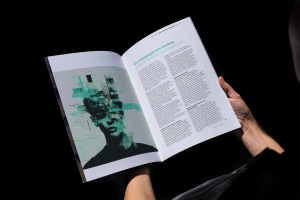How to Lead Through Change
Fonk Magazine interviews Qindle’s co-founder Ype Jorna on how Creative Intelligence blends innovation with structure, aligns creativity with strategy, and leads long-term transformation.
The Challenges of Today that Shape the Future of Tomorrow
In a world where change is the only constant, industries are being reshaped through digital transformation, changing consumer behavior and the increasing demand for a sustainable operation. This raises the question of how to effectively lead through change. What seems like an easy choice in theory becomes more complex in practice, with concerns about the unknown influencing critical decisions. Ype Jorna, cofounder of Qindle, on how Creative Intelligence helps meet today’s challenges in an impactful way.
These shifts are redefining the way businesses should approach growth as well as innovation, to build greater resilience for the long run. For years, short-term ROI and linear metrics have been the basis for top-level decision making, with immediate gains, rapid scaling and an extensive workforce as indicators of success, instead of focusing on sustainable growth. As we move forward, it’s clear that a shift is necessary. Leaders must look beyond the numbers to drive long-term transformation, that leads to a better balance between profitability and responsibility. In today’s business environments, creativity is no longer an optional extra; it is a business imperative. At first glance, it seems obvious: creativity is the driving force behind innovation, the key to differentiation and the foundation for brands aiming to shape the future of their industry. Yet when it’s time to translate bold ideas into action, decision-makers often hesitate. The challenge lies in harmonizing creative vision with business objectives, ensuring that innovation aligns with strategic goals, and that risk-taking is balanced with measurable outcomes.

The dual nature of Creative Intelligence
In response to this dynamic interplay, Qindle has developed a cross-disciplinary methodology called ‘Creative Intelligence’ that distills the best of strategy and creativity, combining them to ignite innovative, impactful solutions designed for the future. It blends fresh, innovative thinking with a structured process to ensure that ideas inspire and deliver tangible business results. It enables businesses to navigate the complexities of innovation confidently, ensuring that bold ideas align with long-term goals. At its core, it transforms creativity from being abstract or impulsive to becoming a thoughtful, calculated investment in the organization’s future.
‘One of Qindle’s most transformative contributions is leading board-level discussions through the lens of Creative Intelligence. Here, creativity shifts from being a tactical tool used in marketing or product development to a core strategic priority that shapes the future of the business. Creative intelligence takes on a broader meaning’, says Ype Jorna, co-founder at Qindle. ‘It is not about the delivery of creative work, it encompasses the ability to think expansively, challenge assumptions, and develop practical strategies that position the company for long-term success.’
Establishing a creative leadership
By integrating Creative Intelligence in leadership practices and day-to-day decision-making, businesses can shift from reacting to market changes to proactively shaping them. By doing so, creativity becomes a core competency that transforms leadership from managing change to guiding it with agility and foresight.
This also shines a different light on the role of a creative consultancy that is moving away from the traditional, executional function into a more dynamic, guiding one. Rather than simply delivering creative work, they can play a crucial role in steering organizations through change. The outsider’s perspective brings fresh insights and offers a different lens through which the business can view their challenges and opportunities. The added value lies in the ability to challenge the status quo, identify untapped potential and provide objective, innovative solutions.
Why Creative Intelligence is Non-Negotiable
One of the key challenges in Creative Intelligence is demonstrating its value in tangible terms. Bold ideas often start as abstract concepts, which can feel distant from the bottomline goals of a business. Since its founding in 2017, Qindle has leveraged Creative Intelligence as guiding principle to bridge the gap by aligning creative initiatives with measurable business objectives—such as increasing brand perception or launching game-changing products. By prototyping, refining, and testing ideas, every creative initiative is optimized for success before full implementation. This step-by-step approach minimizes uncertainty, providing organizations with clarity and confidence in their investments.
Download the article for the Dutch version here.


